steering wheel HONDA CIVIC HYBRID 2014 9.G Owners Manual
[x] Cancel search | Manufacturer: HONDA, Model Year: 2014, Model line: CIVIC HYBRID, Model: HONDA CIVIC HYBRID 2014 9.GPages: 377, PDF Size: 17.8 MB
Page 1 of 377
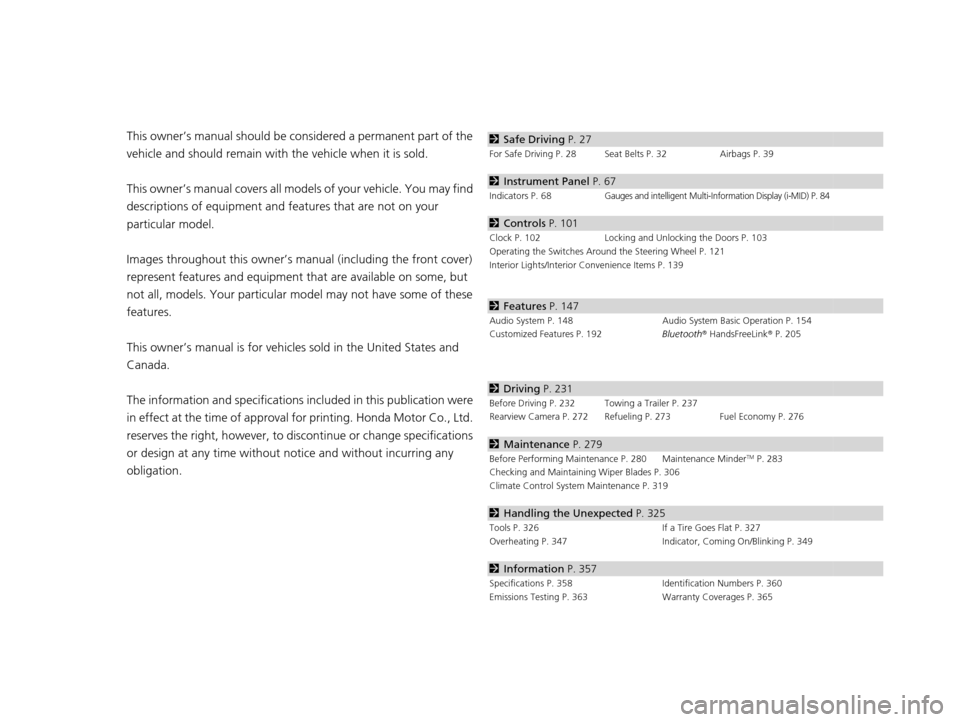
Contents
This owner’s manual should be considered a permanent part of the
vehicle and should remain with the vehicle when it is sold.
This owner’s manual covers all models of your vehicle. You may find
descriptions of equipment and features that are not on your
particular model.
Images throughout this owner’s manual (including the front cover)
represent features and equipment that are available on some, but
not all, models. Your particular mo del may not have some of these
features.
This owner’s manual is for vehicles sold in the United States and
Canada.
The information and specifications in cluded in this publication were
in effect at the time of approval for printing. Honda Motor Co., Ltd.
reserves the right, however, to discontinue or change specifications
or design at any time without notice and without incurring any
obligation.2 Safe Driving P. 27
For Safe Driving P. 28 Seat Belts P. 32 Airbags P. 39
2Instrument Panel P. 67
Indicators P. 68Gauges and intelligent Multi-Information Display (i-MID) P. 84
2Controls P. 101
Clock P. 102 Locking and Unlocking the Doors P. 103
Operating the Switches Around the Steering Wheel P. 121
Interior Lights/Interior Convenience Items P. 139
2 Features P. 147
Audio System P. 148 Audio System Basic Operation P. 154
Customized Features P. 192 Bluetooth® HandsFreeLink ® P. 205
2 Driving P. 231
Before Driving P. 232 Towing a Trailer P. 237
Rearview Camera P. 272 Refueling P. 273 Fuel Economy P. 276
2Maintenance P. 279
Before Performing Maintenance P. 280 Maintenance MinderTM P. 283
Checking and Maintaining Wiper Blades P. 306
Climate Control System Maintenance P. 319
2Handling the Unexpected P. 325
Tools P. 326 If a Tire Goes Flat P. 327
Overheating P. 347 Indicator, Coming On/Blinking P. 349
2Information P. 357
Specifications P. 358 Identification Numbers P. 360
Emissions Testing P. 363 Warranty Coverages P. 365
14 CIVIC IMA-31TR26200.book 0 ページ 2013年12月23日 月曜日 午後4時9分
Page 3 of 377
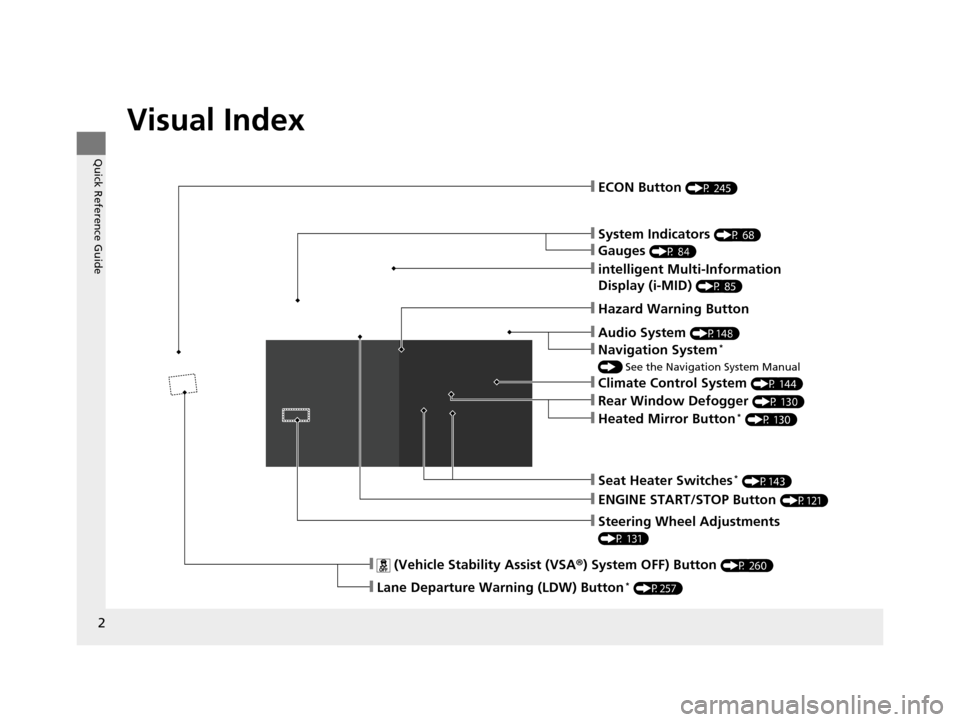
2
Quick Reference Guide
Quick Reference Guide
Visual Index
❙Steering Wheel Adjustments
(P 131)
❙System Indicators (P 68)
❙ECON Button (P 245)
❙Hazard Warning Button
❙ (Vehicle Stability Assist (VSA®) System OFF) Button (P 260)
❙Gauges (P 84)
❙intelligent Multi-Information
Display (i-MID)
(P 85)
❙Audio System (P148)
❙Navigation System*
() See the Navigation System Manual
❙Heated Mirror Button* (P 130)
❙Rear Window Defogger (P 130)
❙Climate Control System (P 144)
❙ENGINE START/STOP Button (P121)
❙Seat Heater Switches* (P143)
❙Lane Departure Warning (LDW) Button* (P257)
14 CIVIC IMA-31TR26200.book 2 ページ 2013年12月23日 月曜日 午後4時9分
Page 13 of 377
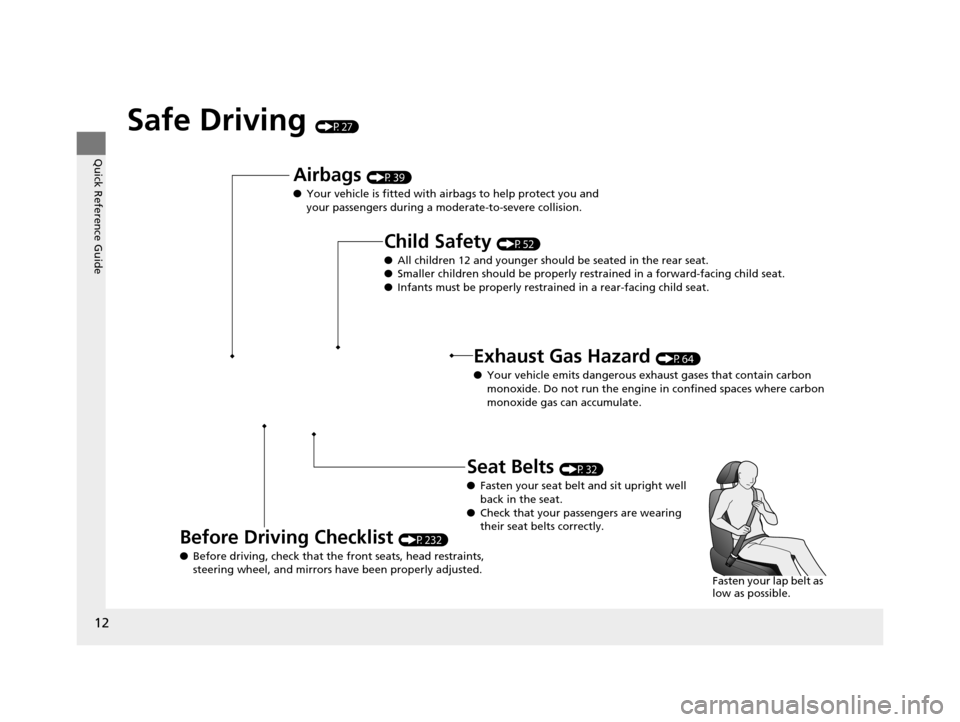
12
Quick Reference Guide
Safe Driving (P27)
Airbags (P39)
● Your vehicle is fitted with ai rbags to help protect you and
your passengers during a moderate-to-severe collision.
Child Safety (P52)
● All children 12 and younger should be seated in the rear seat.
● Smaller children should be properly restra ined in a forward-facing child seat.
● Infants must be properly restrained in a rear-facing child seat.
Exhaust Gas Hazard (P64)
● Your vehicle emits dangerous exhaust gases that contain carbon
monoxide. Do not run the engine in confined spaces where carbon
monoxide gas can accumulate.
Before Driving Checklist (P232)
● Before driving, check that the front seats, head restraints,
steering wheel, and mirrors have been properly adjusted.
Seat Belts (P32)
● Fasten your seat belt and sit upright well
back in the seat.
● Check that your passengers are wearing
their seat belts correctly.
Fasten your lap belt as
low as possible.
14 CIVIC IMA-31TR26200.book 12 ページ 2013年12月23日 月曜日 午後4時9分
Page 16 of 377
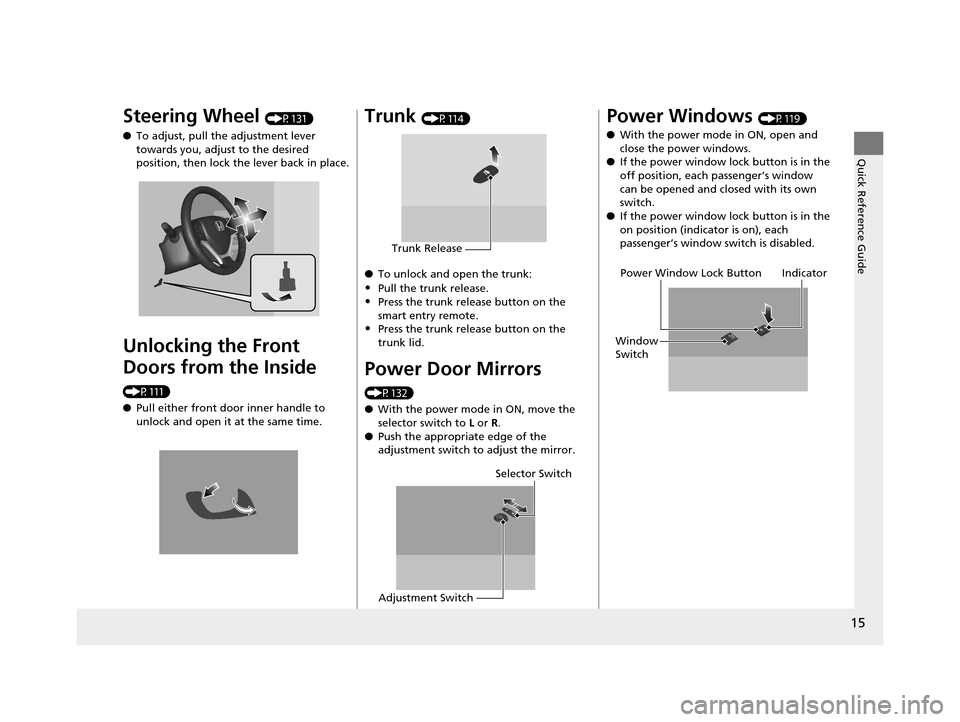
15
Quick Reference Guide
Steering Wheel (P131)
● To adjust, pull the adjustment lever
towards you, adjust to the desired
position, then lock the lever back in place.
Unlocking the Front
Doors from the Inside
(P111)
●Pull either front door inner handle to
unlock and open it at the same time.
Trunk (P114)
● To unlock and open the trunk:
•Pull the trunk release.
•Press the trunk release button on the
smart entry remote.
•Press the trunk release button on the
trunk lid.
Power Door Mirrors
(P132)
●With the power mode in ON, move the
selector switch to L or R .
● Push the appropriate edge of the
adjustment switch to adjust the mirror.
Trunk Release
Selector Switch
Adjustment Switch
Power Windows (P119)
● With the power mode in ON, open and
close the power windows.
● If the power window lock button is in the
off position, each passenger’s window
can be opened and closed with its own
switch.
● If the power window lock button is in the
on position (indicator is on), each
passenger’s window switch is disabled.
Power Window Lock Button
Window
Switch Indicator
14 CIVIC IMA-31TR26200.book 15 ページ 2013年12月23日 月曜日 午後4時9分
Page 23 of 377
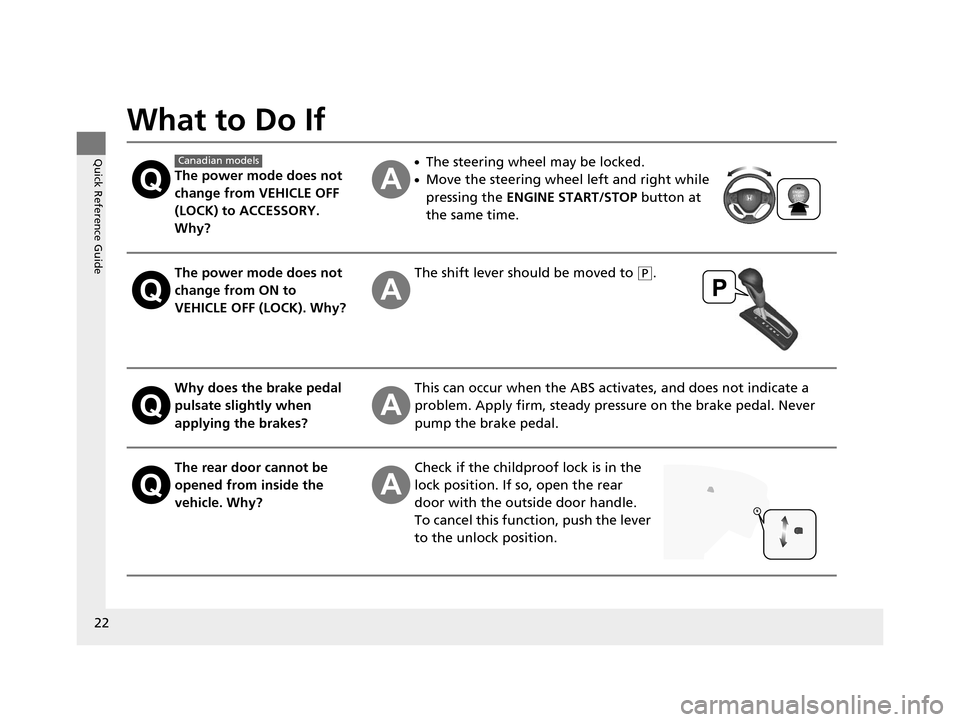
22
Quick Reference Guide
What to Do If
The power mode does not
change from VEHICLE OFF
(LOCK) to ACCESSORY.
Why?
●The steering wheel may be locked.
●Move the steering wheel left and right while
pressing the ENGINE START/STOP button at
the same time.
The power mode does not
change from ON to
VEHICLE OFF (LOCK). Why?The shift lever should be moved to (P.
Why does the brake pedal
pulsate slightly when
applying the brakes?This can occur when the ABS activates, and does not indicate a
problem. Apply firm, steady pressure on the brake pedal. Never
pump the brake pedal.
The rear door cannot be
opened from inside the
vehicle. Why?Check if the childproof lock is in the
lock position. If so, open the rear
door with the outside door handle.
To cancel this function, push the lever
to the unlock position.
Canadian models
14 CIVIC IMA-31TR26200.book 22 ページ 2013年12月23日 月曜日 午後4時9分
Page 41 of 377
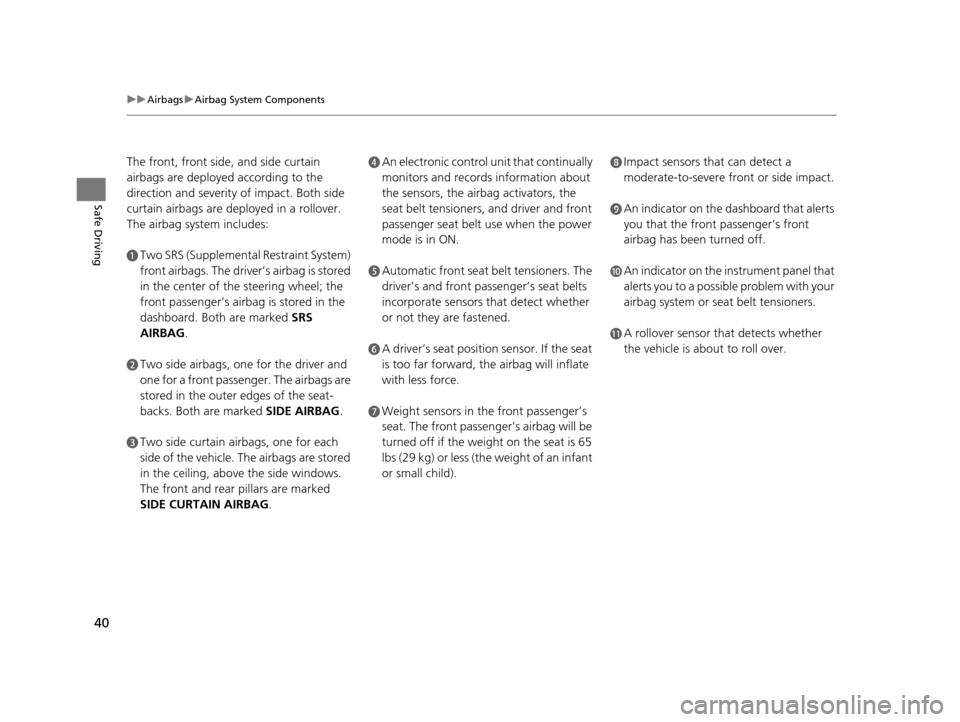
40
uuAirbags uAirbag System Components
Safe Driving
The front, front side, and side curtain
airbags are deployed according to the
direction and severity of impact. Both side
curtain airbags are depl oyed in a rollover.
The airbag system includes:
aTwo SRS (Supplemental Restraint System)
front airbags. The driver’s airbag is stored
in the center of the steering wheel; the
front passenger’s airbag is stored in the
dashboard. Both are marked SRS
AIRBAG.
bTwo side airbags, one for the driver and
one for a front passenger. The airbags are
stored in the outer edges of the seat-
backs. Both are marked SIDE AIRBAG .
cTwo side curtain airbags, one for each
side of the vehicle. The airbags are stored
in the ceiling, above the side windows.
The front and rear pillars are marked
SIDE CURTAIN AIRBAG.
dAn electronic control unit that continually
monitors and records information about
the sensors, the airb ag activators, the
seat belt tensioners, and driver and front
passenger seat belt use when the power
mode is in ON.
eAutomatic front seat belt tensioners. The
driver’s and front passenger’s seat belts
incorporate sensors that detect whether
or not they are fastened.
fA driver’s seat position sensor. If the seat
is too far forward, the airbag will inflate
with less force.
gWeight sensors in the front passenger’s
seat. The front passenger’s airbag will be
turned off if the weight on the seat is 65
lbs (29 kg) or less (the weight of an infant
or small child).
hImpact sensors that can detect a
moderate-to-severe front or side impact.
iAn indicator on the dashboard that alerts
you that the front passenger’s front
airbag has been turned off.
jAn indicator on the instrument panel that
alerts you to a possibl e problem with your
airbag system or seat belt tensioners.
kA rollover sensor that detects whether
the vehicle is about to roll over.
14 CIVIC IMA-31TR26200.book 40 ページ 2013年12月23日 月曜日 午後4時9分
Page 42 of 377
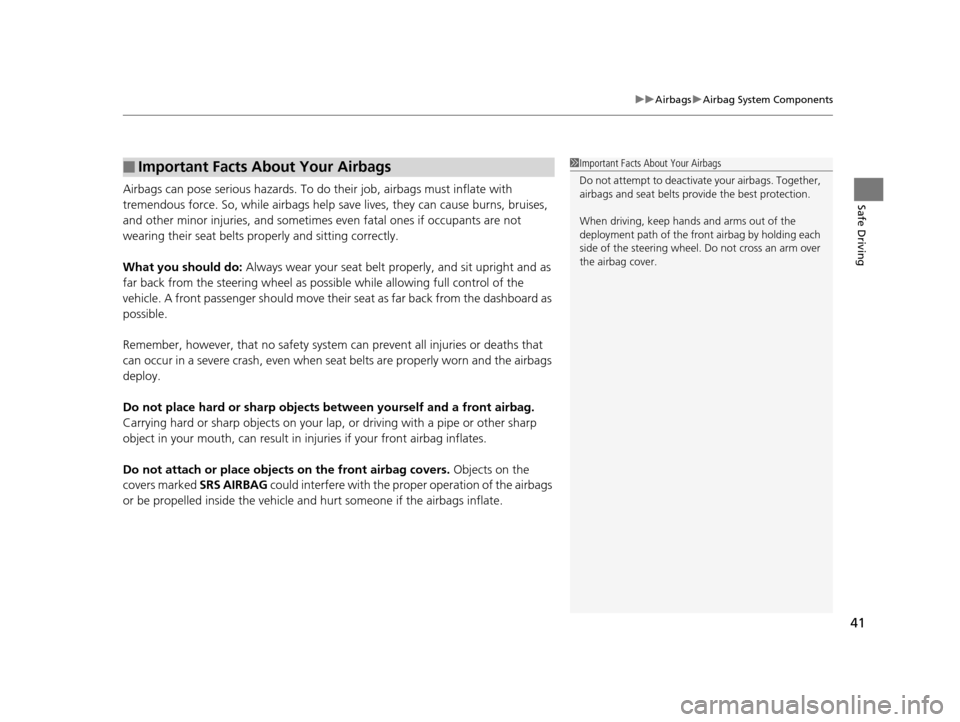
41
uuAirbags uAirbag System Components
Safe DrivingAirbags can pose serious hazards. To do their job, airbags must inflate with
tremendous force. So, while airbags help sa ve lives, they can cause burns, bruises,
and other minor injuries, and sometimes even fatal ones if occupants are not
wearing their seat belts properly and sitting correctly.
What you should do: Always wear your seat belt properly, and sit upright and as
far back from the steering wheel as possi ble while allowing full control of the
vehicle. A front passenger should move their seat as far back from the dashboard as
possible.
Remember, however, that no safety system ca n prevent all injuries or deaths that
can occur in a severe crash, even when s eat belts are properly worn and the airbags
deploy.
Do not place hard or sharp objects between yourself and a front airbag.
Carrying hard or sharp objects on your lap, or driving with a pipe or other sharp
object in your mouth, can result in in juries if your front airbag inflates.
Do not attach or place objects on the front airbag covers. Objects on the
covers marked SRS AIRBAG could interfere with the proper operation of the airbags
or be propelled inside the vehicle an d hurt someone if the airbags inflate.
■Important Facts About Your Airbags1Important Facts About Your Airbags
Do not attempt to deactivate your airbags. Together,
airbags and seat belts pr ovide the best protection.
When driving, keep hand s and arms out of the
deployment path of the front airbag by holding each
side of the steering wheel. Do not cross an arm over
the airbag cover.
14 CIVIC IMA-31TR26200.book 41 ページ 2013年12月23日 月曜日 午後4時9分
Page 43 of 377
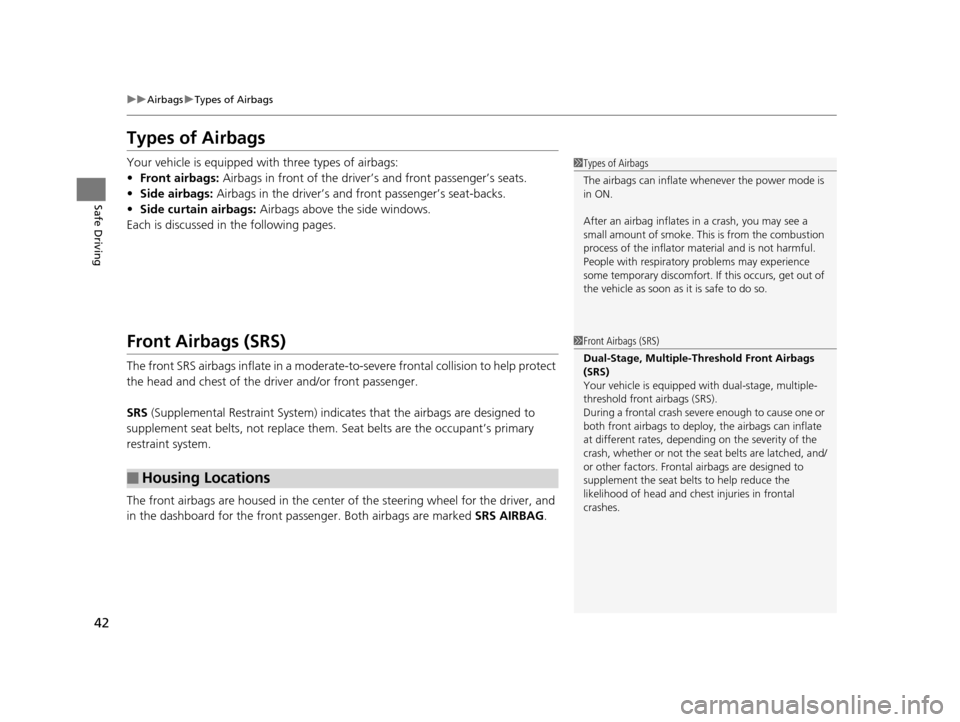
42
uuAirbags uTypes of Airbags
Safe Driving
Types of Airbags
Your vehicle is equipped with three types of airbags:
• Front airbags: Airbags in front of the driver ’s and front passenger’s seats.
• Side airbags: Airbags in the driver’s and front passenger’s seat-backs.
• Side curtain airbags: Airbags above the side windows.
Each is discussed in the following pages.
Front Airbags (SRS)
The front SRS airbags inflate in a moderate-to -severe frontal collision to help protect
the head and chest of the driver and/or front passenger.
SRS (Supplemental Restraint System) indica tes that the airbags are designed to
supplement seat belts, not replace them. Seat belts are the occupant’s primary
restraint system.
The front airbags are housed in the center of the steering wheel for the driver, and
in the dashboard for the front pass enger. Both airbags are marked SRS AIRBAG.
■Housing Locations
1Types of Airbags
The airbags can inflate whenever the power mode is
in ON.
After an airbag inflates in a crash, you may see a
small amount of smoke. This is from the combustion
process of the infl ator material and is not harmful.
People with respiratory pr oblems may experience
some temporary discomfort. If this occurs, get out of
the vehicle as soon as it is safe to do so.
1 Front Airbags (SRS)
Dual-Stage, Multiple-Threshold Front Airbags
(SRS)
Your vehicle is equipped wi th dual-stage, multiple-
threshold front airbags (SRS).
During a frontal crash severe enough to cause one or
both front airbags to deploy, the airbags can inflate
at different rates, dependi ng on the severity of the
crash, whether or not the se at belts are latched, and/
or other factors. Frontal airbags are designed to
supplement the seat belts to help reduce the
likelihood of head and chest injuries in frontal
crashes.
14 CIVIC IMA-31TR26200.book 42 ページ 2013年12月23日 月曜日 午後4時9分
Page 82 of 377
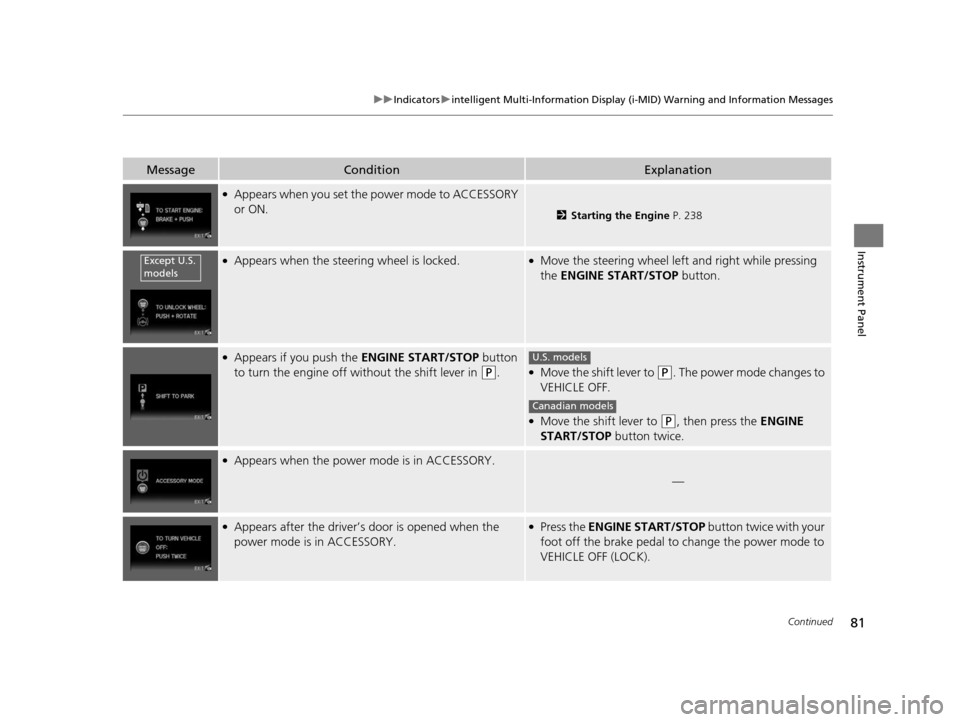
81
uuIndicators uintelligent Multi-Information Display (i-MID) Warning and Information Messages
Continued
Instrument Panel
MessageConditionExplanation
●Appears when you set the power mode to ACCESSORY
or ON.
2 Starting the Engine P. 238
●Appears when the steering wheel is locked.●Move the steering wheel left and right while pressing
the ENGINE START/STOP button.
●Appears if you push the ENGINE START/STOP button
to turn the engine off wi thout the shift lever in
(P.●Move the shift lever to (P. The power mode changes to
VEHICLE OFF.
●Move the shift lever to (P, then press the ENGINE
START/STOP button twice.
●Appears when the power mode is in ACCESSORY.
—
●Appears after the driver’s door is opened when the
power mode is in ACCESSORY.●Press the ENGINE START/STOP button twice with your
foot off the brake pedal to change the power mode to
VEHICLE OFF (LOCK).
Except U.S.
models
U.S. models
Canadian models
14 CIVIC IMA-31TR26200.book 81 ページ 2013年12月23日 月曜日 午後4時9分
Page 102 of 377
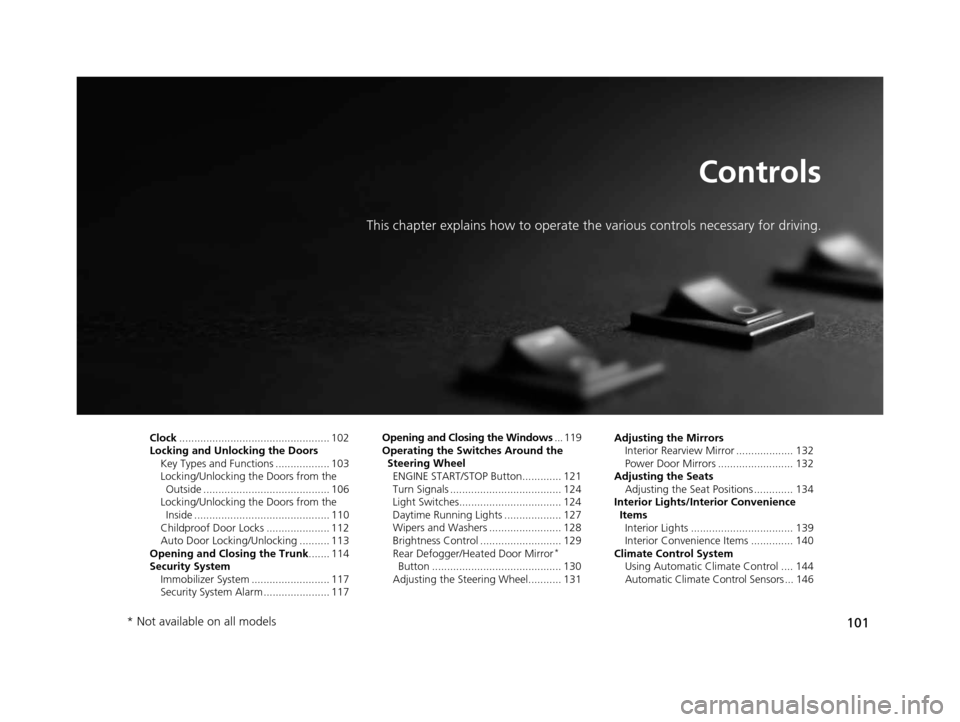
101
Controls
This chapter explains how to operate the various controls necessary for driving.
Clock.................................................. 102
Locking and Unlocking the Doors Key Types and Functions .................. 103
Locking/Unlocking the Doors from the Outside .......................................... 106
Locking/Unlocking the Doors from the
Inside ............................................. 110
Childproof Door Locks ..................... 112
Auto Door Locking/Unlocking .......... 113
Opening and Closing the Trunk ....... 114
Security System Immobilizer System .......................... 117
Security System Alarm ...................... 117 Opening and Closing the Windows
... 119
Operating the Switches Around the Steering Wheel
ENGINE START/STOP Button............. 121
Turn Signals ..................................... 124
Light Switches.................................. 124
Daytime Running Lights ................... 127
Wipers and Washers ........................ 128
Brightness Control ........................... 129
Rear Defogger/Heat ed Door Mirror
*
Button ........................................... 130
Adjusting the Steering Wheel........... 131 Adjusting the Mirrors
Interior Rearview Mirror ................... 132
Power Door Mirrors ......................... 132
Adjusting the Seats Adjusting the Seat Positions ............. 134
Interior Lights/Interior Convenience
ItemsInterior Lights .................................. 139
Interior Convenience Items .............. 140
Climate Control System Using Automatic Climate Control .... 144
Automatic Climate Control Sensors ... 146
* Not available on all models
14 CIVIC IMA-31TR26200.book 101 ページ 2013年12月23日 月曜日 午後4時9分